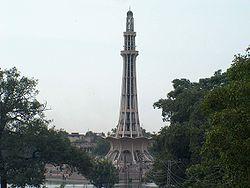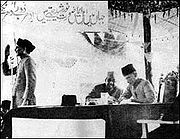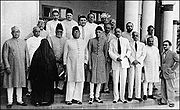
Lahore Resolution
Encyclopedia

British Raj
British Raj was the British rule in the Indian subcontinent between 1858 and 1947; The term can also refer to the period of dominion...
. This has been largely interpreted as a demand for a separate Muslim state, Pakistan
Pakistan
Pakistan , officially the Islamic Republic of Pakistan is a sovereign state in South Asia. It has a coastline along the Arabian Sea and the Gulf of Oman in the south and is bordered by Afghanistan and Iran in the west, India in the east and China in the far northeast. In the north, Tajikistan...
. The resolution was presented by A. K. Fazlul Huq
A. K. Fazlul Huq
Not to be confused with the cricket ground in Dhaka Sher-e-Bangla Cricket Stadium Sher-e-Bangla Abul Kashem Fazlul Huq was a well-known Bengali statesman in the first half of the 20th century...
and was authored by Muhammad Zafrulla Khan
Muhammad Zafrulla Khan
Chaudhry Sir Muhammad Zafarullah Khan, KCSI was a Pakistani politician, diplomat, international jurist, and scholar of the Ahmadiyya Muslim Community, known for drafting the Pakistan Resolution, for his representation of Pakistan at the United Nations, and serving as a judge at the International...
.
Although the name "Pakistan" had been proposed by Choudhary Rahmat Ali
Choudhary Rahmat Ali
Choudhry Rahmat Ali was a Pakistani Muslim nationalist who was one of the earliest proponents of the creation of the state of Pakistan. He is credited with creating the name "Pakistan" for a separate Muslim homeland in South Asia and is generally known as the founder of the movement for its...
in his Pakistan Declaration
Pakistan Declaration
The Pakistan Declaration was a pamphlet published on 28 January 1933 by Choudhary Rahmat Ali, and was supported by Muhammad Aslam Khan Khattak, Sahibzada Sheikh Mohd Sadiq, Inayat Ullah Khan in which the word Pakistan was used for the first time and was presented in the round table conference in...
in 1933, Muhammad Ali Jinnah
Muhammad Ali Jinnah
Muhammad Ali Jinnah was a Muslim lawyer, politician, statesman and the founder of Pakistan. He is popularly and officially known in Pakistan as Quaid-e-Azam and Baba-e-Qaum ....
and other leaders had kept firm their belief in Hindu
Hindu
Hindu refers to an identity associated with the philosophical, religious and cultural systems that are indigenous to the Indian subcontinent. As used in the Constitution of India, the word "Hindu" is also attributed to all persons professing any Indian religion...
-Muslim
Muslim
A Muslim, also spelled Moslem, is an adherent of Islam, a monotheistic, Abrahamic religion based on the Quran, which Muslims consider the verbatim word of God as revealed to prophet Muhammad. "Muslim" is the Arabic term for "submitter" .Muslims believe that God is one and incomparable...
unity. However, the volatile political climate and sidelining of Muslims by Indian National Congress
Indian National Congress
The Indian National Congress is one of the two major political parties in India, the other being the Bharatiya Janata Party. It is the largest and one of the oldest democratic political parties in the world. The party's modern liberal platform is largely considered center-left in the Indian...
showed the future of the Muslims in the subcontinent not so bright and gave the idea stronger backing.
Background
With the beginning of the Second World WarWorld War II
World War II, or the Second World War , was a global conflict lasting from 1939 to 1945, involving most of the world's nations—including all of the great powers—eventually forming two opposing military alliances: the Allies and the Axis...
in September 1939, the Viceroy of India Lord Linlithgow
Victor Hope, 2nd Marquess of Linlithgow
Victor Alexander John Hope, 2nd Marquess of Linlithgow KG, KT, GCSI, GCIE, OBE, PC was a British statesman who served as Governor-General and Viceroy of India from 1936 to 1943.-Early life and family:...
declared India's entrance into the war without consulting the provincial governments. In this situation, Jinnah called a general session of the All India Muslim League in Lahore
Lahore
Lahore is the capital of the Pakistani province of Punjab and the second largest city in the country. With a rich and fabulous history dating back to over a thousand years ago, Lahore is no doubt Pakistan's cultural capital. One of the most densely populated cities in the world, Lahore remains a...
to discuss the circumstances and also analyze the reasons for the defeat of Muslim League in the Indian general election of 1937 in some Muslim majority provinces.
Proceedings

Iqbal Park
Iqbal Park is large area of green space, located at the heart of Lahore city in Pakistan. The park accommodates Minar-e-Pakistan , a 60 meters tall distinctive monument in the shape of a minaret that has been built in commemoration of the Lahore Resolution passed at the three-day general session...
), Lahore
Lahore
Lahore is the capital of the Pakistani province of Punjab and the second largest city in the country. With a rich and fabulous history dating back to over a thousand years ago, Lahore is no doubt Pakistan's cultural capital. One of the most densely populated cities in the world, Lahore remains a...
. The welcome address was made by Nawab Sir Shah Nawaz Mamdot President Punjab All India Muslim League, he was also Chairman of the reception committee and personally bore all the expenses for this august gathering. In his speech, Jinnah recounted the contemporary situation, stressing that the problem of India was no more of an inter-communal nature, but manifestly an international. He criticised the Congress and the nationalist Muslims, and espoused the Two-Nation Theory and the reasons for the demand for separate Muslim homelands. According to Stanley Wolpert
Stanley Wolpert
Stanley Wolpert is an American Indologist, author, and academic. He is considered one of the world's foremost authorities on the political and intellectual history of modern India and Pakistan and has written fiction and nonfiction books on the topics...
, this was the moment when Jinnah, the former ambassador of Hindu-Muslim unity, totally transformed himself into Pakistan's great leader.
Sikandar Hayat Khan, the Chief Minister
Chief Minister
A Chief Minister is the elected head of government of a sub-national state, provinces of Sri Lanka, Pakistan, notably a state of India, a territory of Australia or a British Overseas Territory that has attained self-government...
of the Punjab
Punjab region
The Punjab , also spelled Panjab |water]]s"), is a geographical region straddling the border between Pakistan and India which includes Punjab province in Pakistan and the states of the Punjab, Haryana, Himachal Pradesh, Chandigarh and some northern parts of the National Capital Territory of Delhi...
, was the sole author of the original Lahore Resolution, which was placed before the Subject Committee of the All India Muslim League for discussion and amendments. All claims to the contrary are spurious and due to political infighting and jealousy. Sir Sikander Hyat's Unionist Party had swept the elections in the Punjab and provided support to The Quaid on the urging of Sir Mohammad Allama Iqbal resulting in the Sikander-Jinnah pact. Sir Sikander convinced his class fellow Sir Fazlul Haq, Premier of Bengal to support the Quaid as well. Sir Sikander supported the British in WWII on the request of Sir Winston Churchill after all Indias Political Parties had refused. The British promised Dominion Status to India after the war with Sir Sikander as the Governor General. After his suspicious death other players moved in. Sir Sikander did not envisage Partition of his Beloved Punjab o Bengal. Rather he envisioned a Confederation with Punjab and Bengal as whole sub units. When he learnt of the intended Partition of Punjab he rejected this outright. The strike by the Khaksaar Taireek and subsequent killing of their workers while Sir Sikander was Acting Governor of the Punjab was a spoiler and an attempt by their leader to hijack the Freedom Movement. The Taireek had supported the Germans and Japanese during the War. Due to Civil Unrest it was decided that Sir Fazlul Haq would present the Resolution. The Resolution text unanimously rejected the concept of a United India on the grounds of growing inter-communal violence and recommended the creation of an independent Muslim state.
After the presentation of the annual report by Liaquat Ali Khan
Liaquat Ali Khan
For other people with the same or similar name, see Liaqat Ali Nawabzada Liaquat Ali Khan was a Pakistani statesman who became the first Prime Minister of Pakistan, Defence minister and Commonwealth, Kashmir Affairs...
, the Resolution was moved in the general session by A.K. Fazlul Huq, the Chief Minister of undivided Bengal
Bengal
Bengal is a historical and geographical region in the northeast region of the Indian Subcontinent at the apex of the Bay of Bengal. Today, it is mainly divided between the sovereign land of People's Republic of Bangladesh and the Indian state of West Bengal, although some regions of the previous...
and was seconded by Choudhury Khaliquzzaman who explained his views on the causes which led to the demand of a separate state. Subsequently, Maulana Zafar Ali Khan from Punjab, Sardar Aurangzeb from the North-West Frontier Province
North-West Frontier Province
Khyber Pakhtunkhwa , formerly known as the North-West Frontier Province and various other names, is one of the four provinces of Pakistan, located in the north-west of the country...
, Sir Abdullah Haroon from Sindh, and Qazi Esa from Baluchistan
Balochistan (region)
Balochistan or Baluchistan is an arid, mountainous region in the Iranian plateau in Southwest Asia; it includes part of southeastern Iran, western Pakistan, and southwestern Afghanistan. The area is named after the numerous Baloch tribes, Iranian peoples who moved into the area from the west...
, and other leaders announced their support. In the same session, Jinnah also presented a resolution to condemn the Khaksar massacre of 19 March, owing to a clash between the Khaksars
Khaksars
The Khaksar movement was a social movement based in Lahore, British India, established by Allama Mashriqi in 1931 to free India from the rule of the British Empire and establish a Hindu-Muslim government in India The word "Khaksar" is derived from the Persian language, Khak means dust, and Sar...
and the police, that had resulted in the loss of lives.
The statement
The principle text of the Lahore Resolution was signed actually on 24 March, but officially 23 March is considered as signing date of that resolution. In 1941 it became part of the Muslim League's constitutionConstitution
A constitution is a set of fundamental principles or established precedents according to which a state or other organization is governed. These rules together make up, i.e. constitute, what the entity is...
. In 1946, it formed the basis for the decision of Muslim League to struggle for one state for the Muslims. The statement declared:
Additionally, it stated:
Pakistan resolution in the Sindh Assembly
The SindhSindh
Sindh historically referred to as Ba'ab-ul-Islam , is one of the four provinces of Pakistan and historically is home to the Sindhi people. It is also locally known as the "Mehran". Though Muslims form the largest religious group in Sindh, a good number of Christians, Zoroastrians and Hindus can...
assembly was the first British Indian legislature to pass the resolution in favour of Pakistan. G. M. Syed
G. M. Syed
G. M. Syed was a political leader who pioneered the Jeay Sindh movement for the freedom of Sindh from Pakistan. He is regarded as one of the founding fathers of modern Sindhi nationalism...
, an influential Sindhi activist, revolutionary and Sufi and one of the important leaders to the forefront of the provincial autonomy movement joined the Muslim League in 1938 and presented the Pakistan resolution in the Sindh Assembly. This text was buried under the Minar-e-Pakistan during its building in the Ayub regime.
Commemoration

- To commemorate the event, Minar-e-PakistanMinar-e-PakistanMinar-e-Pakistan is a tall minaret in Iqbal Park Lahore, built in commemoration of the Lahore Resolution. The minaret reflects a blend of Mughal and modern architecture, and is constructed on the site where on March 23, 1940, seven years before the formation of Pakistan, the Muslim League passed...
, a 60 meter tall monumentMonumentA monument is a type of structure either explicitly created to commemorate a person or important event or which has become important to a social group as a part of their remembrance of historic times or cultural heritage, or simply as an example of historic architecture...
in the shape of a minaretMinaretA minaret مناره , sometimes مئذنه) is a distinctive architectural feature of Islamic mosques, generally a tall spire with an onion-shaped or conical crown, usually either free standing or taller than any associated support structure. The basic form of a minaret includes a base, shaft, and gallery....
was built at the site in Iqbal ParkIqbal ParkIqbal Park is large area of green space, located at the heart of Lahore city in Pakistan. The park accommodates Minar-e-Pakistan , a 60 meters tall distinctive monument in the shape of a minaret that has been built in commemoration of the Lahore Resolution passed at the three-day general session...
where the resolution was passed. - 23 March is a national holiday in Pakistan, to commemorate Lahore ResolutionLahore ResolutionThe Lahore Resolution , commonly known as the Pakistan Resolution , was a formal political statement adopted by the Muslim League at the occasion of its three-day general session on 22–24 March 1940 that called for greater Muslim autonomy in British India...
(1940) as well as the Republic DayRepublic Day (Pakistan)Pakistan Day is a national holiday in Pakistan to commemorate the Lahore Resolution of 1940 and also to celebrate the adoption of the first constitution of Pakistan in 1956 during the transition of the Dominion of Pakistan to the Islamic Republic of Pakistan of 23 March 1956.-History:Pakistan had...
(1956); the country became the first Islamic RepublicIslamic republicIslamic republic is the name given to several states in the Muslim world including the Islamic Republics of Pakistan, Iran, Afghanistan, and Mauritania. Pakistan adopted the title under the constitution of 1956. Mauritania adopted it on 28 November 1958. Iran adopted it after the 1979 Iranian...
in the world.
External links
- The Pakistan Resolution, Government of PakistanGovernment of PakistanThe Government of Pakistan is a federal parliamentary system, with an indirectly-elected President as the Head of State and Commander in Chief of the Pakistani Armed Forces, and an indirectly-elected Prime Minister as the Head of Government. The President’s appointment and term are...
Official website. (Retrieved on 23 April 2006) - Lahore Resolution (1940) at Story of Pakistan website. (Retrieved on 23 April 2006)
- Lahore Resolution at Asiatic Society of Bangladesh.(Retrieved on 23 April 2006)
- Pakistan Resolution or Muslim League's Search For Survival

